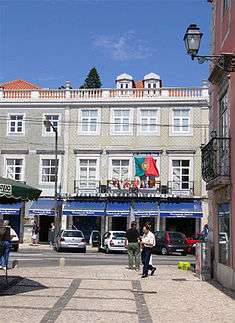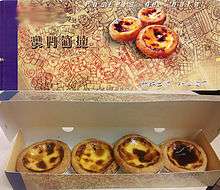Pastel de nata
|
The typical appearance of the pastel de nata, in this case, produced in Macau | |
| Alternative names | Pastel de Belém |
|---|---|
| Course | Dessert |
| Place of origin | Portugal |
| Region or state | Santa Maria de Belém, Lisbon (originally); produced worldwide within the Lusosphere |
| Creator | Religious of the Monastery of the Hieronymites |
| Serving temperature | Fresh from oven, with cinnamon and icing sugar |
| Main ingredients | Egg yolks |
| Variations | Regional |
| 298 per 100 grams (3.5 oz) kcal | |
|
| |
Pastel de nata (Portuguese pronunciation: [pɐʃˈtɛɫ dɨ ˈnatɐ]; plural: pastéis de nata), is a Portuguese egg tart pastry, common in Portugal, the Lusosphere countries and regions (which include Brazil, Angola, Mozambique, Cape Verde, São Tomé and Príncipe, Guinea-Bissau, Timor-Leste, Goa, Malacca and Macau, introducing them later in Mainland China), and countries with significant Portuguese immigrant populations, such as Canada, Australia, Luxembourg, the United States, and France, among others.
History

Pastéis de nata were created before the 18th century by Catholic monks at the Jerónimos Monastery (Portuguese: Mosteiro dos Jerónimos) in the civil parish of Santa Maria de Belém, in Lisbon. These monks were originally based in France and loved these pastries which could be found in local French bakeries. At the time, convents and monasteries used large quantities of egg-whites for starching of clothes, such as nuns' habits. It was quite common for monasteries and convents to use the leftover egg yolks to make cakes and pastries, resulting in the proliferation of sweet pastry recipes throughout the country.
Following the extinction of the religious orders and in the face of the impending closing of many of the convents and monasteries in the aftermath of the Liberal Revolution of 1820, the monks started selling pastéis de nata at a nearby sugar refinery to secure some revenue. In 1834 the monastery was closed and the recipe was sold to the sugar refinery, whose owners in 1837 opened the Fábrica de Pastéis de Belém. The descendents own the business to this day.[1]
Since 1837, locals and visitors to Lisbon have visited the bakery to purchase fresh from the oven pastéis, sprinkled with cinnamon and powdered sugar. Their popularity normally results in long lines at the take-away counters, in addition to waiting lines for sit-down service.
Characteristics
The simple recipe has had various alterations in the Portuguese pastelarias (pastry shops) and padarias (bakeries), in the shape of the pastry cup and the filling. Some prefer the cream slightly "curdled" to give it a rustic appearance and unusual texture.
In the Azores, the pastries are referred to as queijadas de nata, rather than the title pastéis de nata used in mainland Portugal; in northern Portugal the abbreviated form nata is used in all but the most technical contexts.

Foreign acknowledgement and propagation
- In 2006, this confection was chosen to represent Portugal in the European Union Café Europe initiative, held by the rotating-presidency under Austria for Europe Day.
- Pastéis de nata were introduced in China after gaining their popularity in Macau, when this Special Administrative Region was under the Portuguese government. In the Chinese the pastries are known as zh:葡撻 (traditional) or 葡挞 (simplified), which in pinyin can be read as pó-tà (in Cantonese the word has a similar ending sound to the Portuguese word nata), meaning Portuguese tart. This is different to 蛋撻 , or dàn-tà, which refers to Hong Kong style egg tarts, which are widely available in Hong Kong style bakeries and restaurants. Western fast food restaurants chains in Asia (such as Kentucky Fried Chicken and McDonald's) include the dàn-tà as desserts since the 1990s, which facilitated their acceptance in many Asian countries: Cambodia, Singapore, Malaysia, Taiwan (popularized by bakery franchises such as Lord Stow's bakery) and the other Chinese SAR, Hong Kong.
- Nowadays the Pastéis de Nata recipe can be learned through pastry classes in the Portuguese capital or cooking schools.
- The Pastéis de Belém were mentioned by The Guardian as the 15th most tasty delicacy in the world.[2]
See also
References
- Notes
- ↑ http://www.cmjornal.xl.pt/detalhe/noticias/outros/domingo/175-anos-de-pasteis-de-belem
- ↑ Fox, Killian (13 September 2009). "The 50 best things to eat in the world, and where to eat them (The Guardian)". London.
- Sources
- Merle, Dominick (11 August 2004), "There's history - and a secret - in every bite", The Christian Science Monitor, retrieved 23 April 2012
- Amaral, André; Pires, Carla; Castro e Silva, Daniel; Medeiros, Luís; André, Mário Rui (December 2011), O Segredo do Marketing dos Pastéis de Belém (PDF) (in Portuguese), Lisbon, Portugal: Escola Superior de Comunicação Social, Instituto Politécnico de Lisboa
External links
- Pastéis de Belém: Hot on the Trail of a Legend from Leite's Culinaria
